Tempest’s Downpour – Anime In-Jokes 10 – Anime Emotions

On top of being bright, colorful and completely insane, anime tends to have a wide variety of super-expressive emotions. It can be a struggle for first-time anime viewers to keep up with all the symbols racing around the screen or page. Even seasoned veterans of anime don’t understand every circumstance for every facial symbol.
I’m going to start with the basics of anime expressions: most emotions are found in the eyes, as opposed to the mouths. A character can go through shock, happiness and sadness without ever changing their mouth shapes. If you look at Japanese emoticons, they’re all eye-centric while in most European nations focus on the mouth.
Compare:
^_^ to :)
O_O to :O
¬_¬ to :/
Okay, so you’ve watched enough anime to get that they have big eyes. Big deal. What about the extraneous things? Why does a giant blue water droplet show up on the side of someone’s head when they’re embarrassed? And is it author laziness when a character’s eyes turn wide and white as saucers?
The most common expression you’ll find throughout anime is probably the Sweat Drop. It takes the form of a light blue water droplet affixed to the side of a character’s head. This is normally accompanied by a sheepish expression where the eyebrows are pressed together and the eyes are squeezed shut. Sometimes this is accompanied by a hand motion that circles around the ear — similar to the “crazy” expression of Western cultures — as a sign of embarrassment in Japan.
Even the most realistically animated shows can take a moment to fashion a Sweat Drop to the side of a character’s head. It is a sign of embarrassment, exasperation, confusion or mild distress and is typically used in response to another character’s erratic behavior. A more extreme version of a Sweat Drop can be found in Sailor Moon, where the titular character exasperates the other characters so badly that they all literally flip over, so that their legs are the only things showing on the screen for a few seconds.

Ed is embarrassed by Hughes’ outlandish behavior.
Another common anime expression is the Anger Vein, also known as the Cross-Popping Vein. When an character is outraged, angry or holding back anger, a bizarre red series of marks like “<" or "Y" will appear bulging out of the person's forehead (or hand if they're holding back). These are usually done for comedic effect, but I'm relatively certain I've seen them in fighting shows like Dragonball Z.
This symbol has made its way into media around the world including the British program Stressed Ed. I’ve seen it multiple times on Teen Titans, and The Angry Video Game Nerd uses it as part of his logo.

Kagami’s anger is highlighted.
Embarrassed… shocked… do anime characters get scared? The easy answer is: practically all the time. When confronted with their biggest fear or a terrible situation in general, a character may overreact so strongly that his/her face turns blue from the cheeks upwards. This is sometimes accompanied by three vertical lines that hang beneath one eye. In a variation, sometimes squiggly blue lines rise like steam from the top of a character’s head.
Occasionally, a character will become so frightened that his/her soul will escape attempt to escape through the mouth. This only happens for comedic purposes and sometimes is from the shock of something that isn’t scary, like overwork mixed with starvation in the case of Excel Saga.

Tomoya and Kotomi look absolutely terrified. Tomoya expresses standard blue terror while Kotomi has the variation with blue lines.
Whatever the character’s overreaction method is, this is normally accompanied by badly drawn, wide, white disks that take the place of the eyes. This exaggerated appearance makes it seem like the artist went on vacation. Characters can take on this appearance when they’re stunned, despaired, terrified or, in some cases, manic.
The scribbly, wide, saucer-eyes are relatively commonplace in more recent anime, though are not as common in older shows. Sometimes the eyes rotate in a circular pattern and weave into one another. These eyes can be mistaken for glasses in crowd scenes.
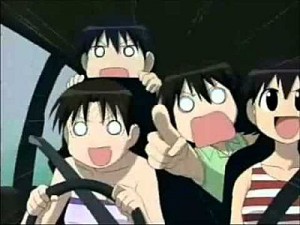
Azu Manga Daioh illustrates three types of White Saucer Eyes: Manic (left-bottom), Stunned/Confused (left-top) and Terrified (middle).
One gag that has been running through anime for almost as long as the Sweat Drop is the Nosebleed. In Tenchi Muyo! especially this is especially rampant, since 1) it’s one of the first harem anime and 2) the girls are caught naked just about every episode. A Nosebleed, originally designed for male characters, signifies that the character has just walked in on something naughty and likes it. He can protest, and try to cover the red mark on his face, but the evidence is hard to look past.
Lately, female characters have been getting Nosebleeds, though they’re typically reserved for females in male positions (the dominant female in a yuri) or yaoi fangirls (since they think about boys so much, I guess. I don’t really get the connection). The anime Nosebleed is based on an old wive’s tale that a nosebleed is a sign of thinking dirty thoughts. It’s played up for comedic effect, and what started off as a small spurt has turned alarmingly into waterfalls of blood.

This is really more alarming than funny…
Finally, the most common, and perhaps most bizarre aspect, of anime is the Super-Deformed (or Chibi) character. A scene is happening where two characters are having a serious discussion. Suddenly, BAM, the background changes to something stylistically simplistic the art style goes out the window and the characters are rendered about two feet tall with stubby arms/legs and emoticon facial expressions. Then, two seconds later, everything goes back to normal. Has this anime gone on crack? No! That SD/Chibi physics for you.
Nearly every anime I can think of has moments where a character goes Chibi, and this is always played for comedic effect. This usually happens when the character is experiencing an extreme emotion: shock, fear, anger, thrill and even happiness. This is especially popular in 90’s anime: Magic Knight Rayearth, Fushigi Yugi, even serious shows like Ruroni Kenshin have their moments.
Chibi-form is such a staple of anime that it can be used as part of marketing to promote a program or product. Some popular manga artists render themselves in chibi form: CLAMP, Miho Obana, Svetlana Chmakova and more. When a character goes chibi, they can defy physics by floating in the air or walking along walls and tend to exhibit the most extreme version of the emotion they feel: anger can have a >.< face complete with flailing arms, angry lines floating out of the head and stamping feet. There's a scene in Kodocha where Fuka gets so mad at Sana that she dashes up the stairs of the playground, shouts “I hate Sana” and slides down the slide with a blank expression all in one frame.

Hikaru is experiencing an overabundance of emotion, and thus went into Chibi-form.
Because it’s an animated forum, characters can break all the rules of logic and thus express themselves more openly than any of us can in every day life. (Though have you noticed that long-time anime fans tend to be more expressive, such as flailing with their arms and looking at things with wide eyes, with their hands clutched together in cutesy expressions? We even strike poses.) That’s probably one of the aspects of anime that draws us in: characters may not smile quite as widely with their mouths, but they express their emotions in ways that hit home inside of each of us.
For more information on any of the subjects covered in this article, visit:
TV Tropes: Sweatdrop
TV Tropes: Cross Popping Veins
TV Tropes: Blue With Shock
TV Tropes: Nosebleed (not safe for work)
TV Tropes: Super-Deformed



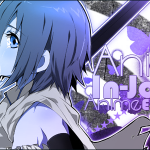
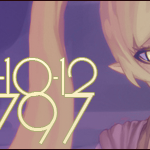

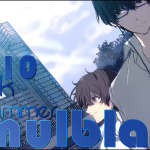


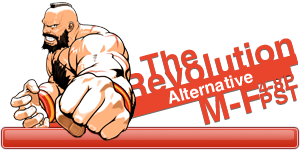
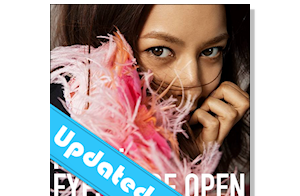





Great article. Makes me wonder if these techniques to portray emotions/emotional state are are result of mangaka inventions or animators?
Have to add the one: the slightly down-looking and completely blackend eye area – when the character is in a bit of controlled rage and about to express something big, in words or actions or often both. Love that ’cause you know something is about to happen….